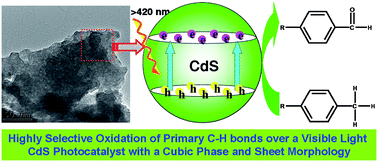Transforming CdS into an efficient visible light photocatalyst for selective oxidation of saturated primary C–H bonds under ambient conditions†
Abstract
Selective

* Corresponding authors
a
State Key Laboratory Breeding Base of Photocatalysis, College of Chemistry and Chemical Engineering, Fuzhou University, Fuzhou 350002, P. R. China
E-mail:
yjxu@fzu.edu.cn
Fax: +86 591 83779326
Tel: +86 591 83779326
b College of Chemistry and Chemical Engineering, New Campus, Fuzhou University, Fuzhou, P. R. China
Selective

 Please wait while we load your content...
Something went wrong. Try again?
Please wait while we load your content...
Something went wrong. Try again?
Y. Zhang, N. Zhang, Z. Tang and Y. Xu, Chem. Sci., 2012, 3, 2812 DOI: 10.1039/C2SC20603J
To request permission to reproduce material from this article, please go to the Copyright Clearance Center request page.
If you are an author contributing to an RSC publication, you do not need to request permission provided correct acknowledgement is given.
If you are the author of this article, you do not need to request permission to reproduce figures and diagrams provided correct acknowledgement is given. If you want to reproduce the whole article in a third-party publication (excluding your thesis/dissertation for which permission is not required) please go to the Copyright Clearance Center request page.
Read more about how to correctly acknowledge RSC content.
 Fetching data from CrossRef.
Fetching data from CrossRef.
This may take some time to load.
Loading related content
